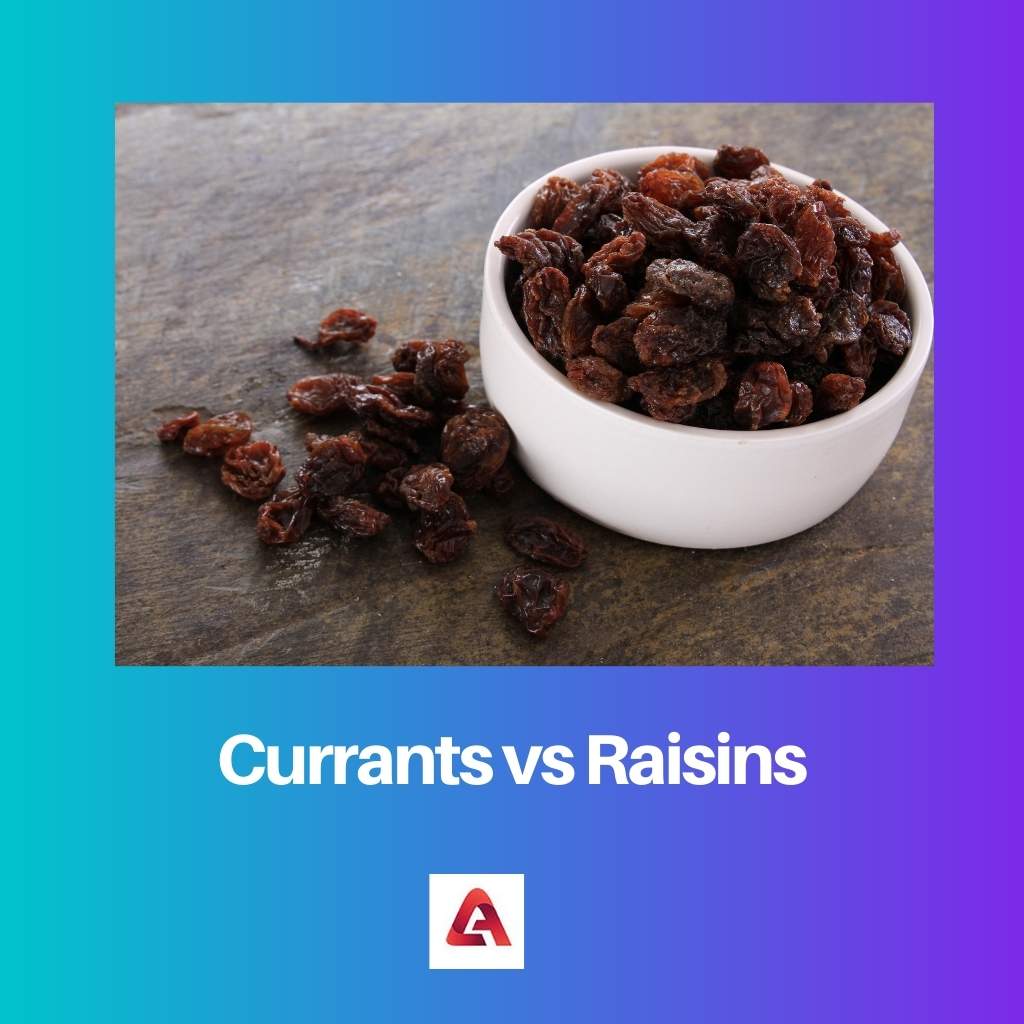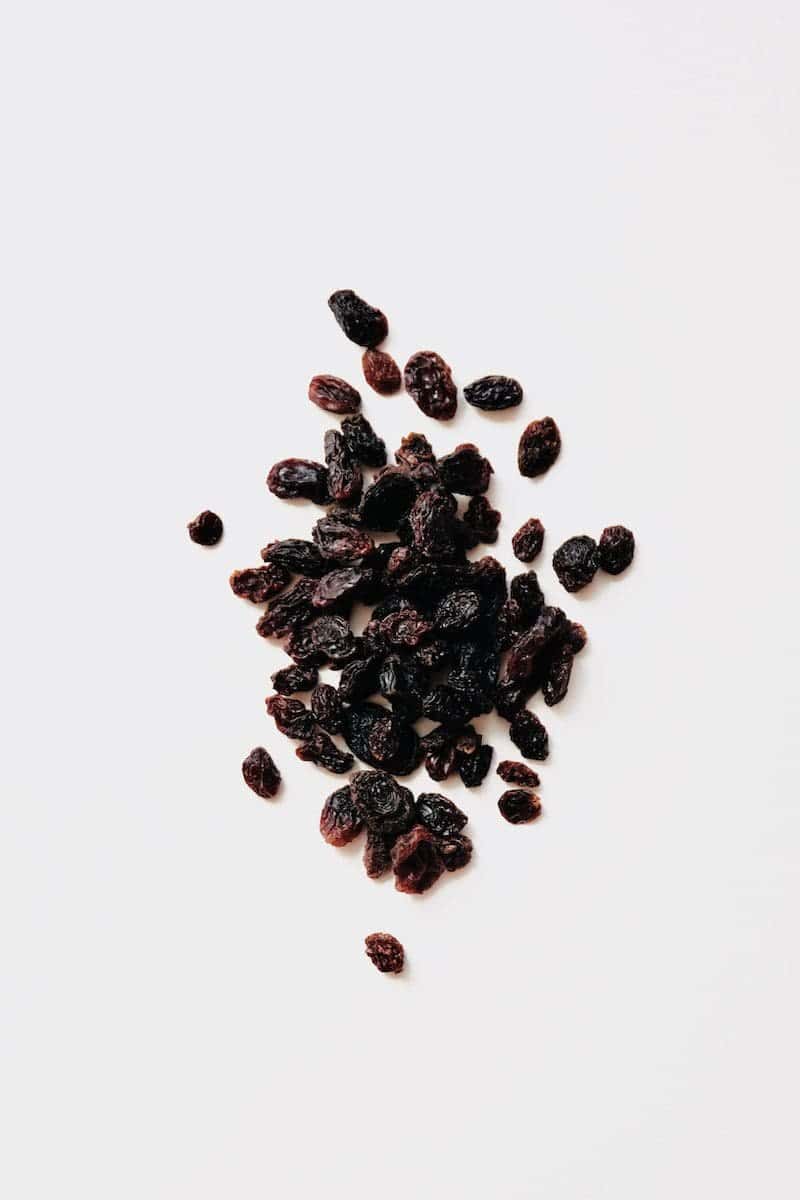Dried fruits such as currants and raisins are very popular. They’re various kinds of dried grapes, to be precise. They’re packed with vital vitamins, minerals, and antioxidants, and they’re used in both sweet and savoury recipes throughout the globe.
Despite their widespread appeal, there is still a lot of missing information about these delectable sweets.
Key Takeaways
- Currants are small, tart berries that are dried and used in baking or as a snack, while raisins are larger and sweeter grapes that are also dried.
- Currants are black or red, while raisins can be made from various grapes and are brown or golden.
- Currants are less common than raisins and can be more difficult to find in grocery stores.
Currants vs Raisins
The difference between currants and raisins is the flavour and look of currants and raisins. Black currant is darker in color, richer in flavour, sweeter, and fuller, while raisins are larger and deeper than black currant. Some currants are really tiny, seedless raisins rather than raisins (dried grapes). A currant is also one of the several shrubs that are members of the saxifrage family, as well as the fruit produced by that plant. A raisin, in particular, is a dried big, black grape that has been dried.

Currants, commonly known as “Zante currants,” are dried grapes that are small and sweet. Currants are produced by drying a type of tiny, seedless grapes named “Black Corinth” and “Carina,” despite their name.
Currants are dried for up to three weeks before being used. They have a sweet, full-bodied, full-bodied taste, and due to their small size, they add texture and sweetness to sweet and savoury foods.
Raisins are grapes that have been dried for about three weeks. The raisins are dark brown because the color will become darker after the raisins. Raisins are made from a variety of grape varieties.
The size, flavour, and color of the grapes used all depend on the type of grapes used. Raisins are produced from the Thompson Seedless type in the United States.
Comparison Table
| Parameters of Comparison | Currants | Raisins |
|---|---|---|
| Features | Currants are dried, seedless, dark red grapes that are also known as black Corinth grapes. | Raisins are dried grapes, particularly white-fleshed grapes that have been dried. |
| Size | Small as compared to raisins. | Large. |
| Texture | They have a chewy feel and a wrinkled appearance. | They have a chewy texture. |
| Taste | Sweet and Tangy. | Soft and sweet. |
| Soak | Do not soak up other flavors. | Soak up other tastes quite nicely. |
What are Currants?
Currants are dried, dark red, seedless grapes. Fresh currants are tiny berries that are white, black, or red in color and are approximately the size of peas. Surprisingly, the dried fruits marketed as currants are produced from grapes, not currants!
Black Corinth grape is a common name for the currants we use as dried fruits. The name Corinth is derived from the ancient Greek city of Corinth. Zante cassis and Corinthian raisins are the other two names for cassis.
Current is mostly used in the United Kingdom and Ireland. Black Corinth grapes were first grown in Greece, specifically on the island of Zante, which is why they are also referred to as Zante currants by some.
When dried, these grapes create a shrivelled, black, sweet-tasting fruit. Truly edible currants are members of the Ribes family of flowering shrubs that grow best in northern regions with warm summers and freezing winters, as well as in the tropics.
It is preferable to let the small berries mature on the vine rather than picking them off the plant. Currants have been grown throughout Europe for hundreds of years.

What are Raisins?
Raisins are dried grapes, dried grapes with white flesh that have been dried. At first, the skin of these grapes is green in color, but it darkens as they dry, much like the skin of currants.
Dried fruits have a thick texture and a sweet flavour that bursts out from their dried state. Raspberries are mostly produced in the United States, Greece, Turkey, and Australia, among other places.
Raisins, in contrast to currants, have the ability to absorb various flavours. This is why raisins are soaked in alcoholic beverages such as brandy before being cooked.
This soaking technique enhances the flavour of a meal. Raisins may be used in a variety of baked goods, including cakes, puddings, and confectionery. They may also be used to make oatmeal and granola bars, among other things.
Grapes are treated with sulfur dioxide, the same chemical ingredient used in winemaking to prevent oxidation from giving them their golden color. The delicate hue of the grapes is preserved with this treatment.
Artificial heat is also used to dry golden raisins (rather than drying them on the vine like their traditional counterpart). This heat accelerates the drying process, resulting in plumper raisins with more moisture and a tangier taste.

Main Differences Between Currants and Raisins
- Currants are dried, dark red, seedless grapes that are referred to as black Corinth grapes. Raisins are dried grapes, particularly dried white-fleshed grapes, which are a kind of grape.
- The size of currants is smaller as compared to raisins, whereas raisins have a larger size than currants.
- Currants have a chewy and wrinkled texture, whereas raisins have only a chewy texture.
- Currants taste is sweet and tangy, whereas raisins are soft and sweet
- Currants do not soak up other flavours, whereas raisins soak up other tastes quite nicely.

- https://www.tandfonline.com/doi/abs/10.1080/02652030310001615212
- https://onlinelibrary.wiley.com/doi/abs/10.1111/1750-3841.13854





Thank you for explaining the difference between currants and raisins. Very informative indeed!
I agree, it was very helpful.
This article has broadened my knowledge about currants and raisins, and I appreciate the detailed information.
I couldn’t agree more. It’s great to learn about such topics.
This comprehensive breakdown of currants and raisins has been incredibly educational. Thank you for providing such valuable information.
I can’t agree more. Well-written and informative.
The article effectively provided a detailed overview of currants and raisins, shedding light on several aspects that were previously unknown to me. Thank you for sharing this insightful piece!
I completely agree. The depth of information presented here is commendable.
The explanations on the uses and global distribution of currants and raisins were very informative. It’s great to learn about their widespread applications.
Absolutely. It’s fascinating to see how these dried fruits are used in various cuisines.
This article was a great read. It thoroughly explains the differences between currants and raisins, and I appreciate its educational value.
Certainly. The level of detail provided is impressive.
The details about the production and characteristics of currants and raisins were very enlightening. Thank you for sharing!
A great read indeed. I learned a lot from this article.
The historical background of currants and raisins is fascinating. Thank you for including it in the article.
Absolutely, the historical context adds another layer of interest to the topic.
The comparison table provided great insights. It’s interesting to see the differences between currants and raisins outlined so clearly.
I appreciate the thorough explanation of their features.
Definitely! I found it very informative.
The comparison of the taste and texture of currants and raisins was particularly insightful. Thanks for the detailed comparison!
Indeed, the differences in taste and texture were explained very clearly.